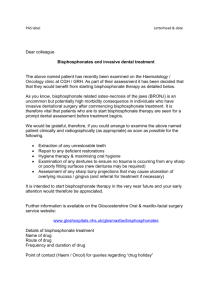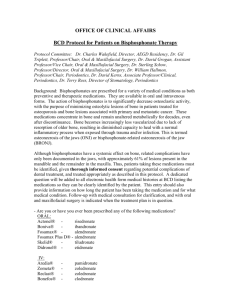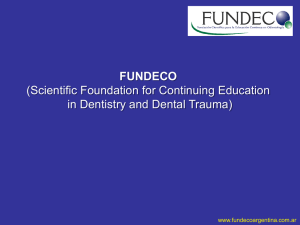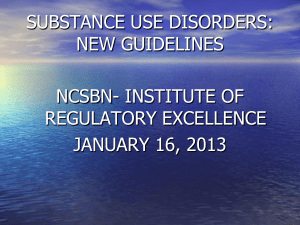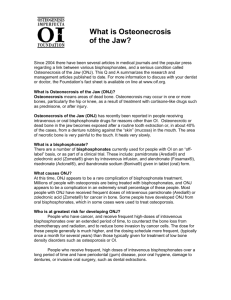Osteonecrosis of the jaw
advertisement
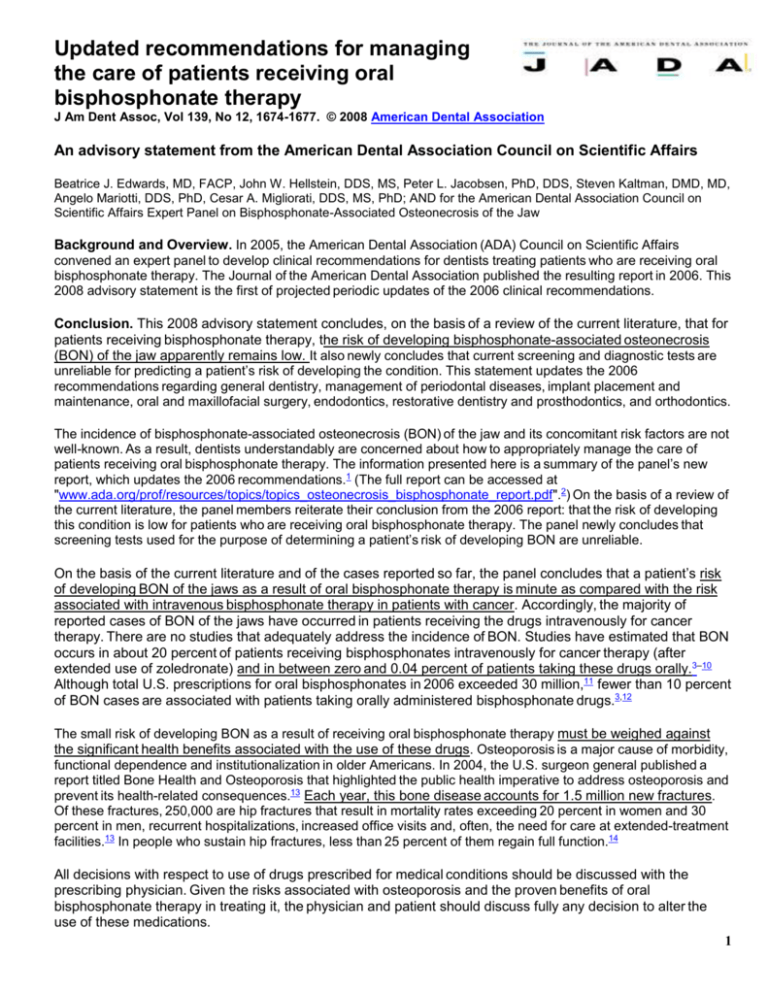
Updated recommendations for managing the care of patients receiving oral bisphosphonate therapy J Am Dent Assoc, Vol 139, No 12, 1674-1677. © 2008 American Dental Association An advisory statement from the American Dental Association Council on Scientific Affairs Beatrice J. Edwards, MD, FACP, John W. Hellstein, DDS, MS, Peter L. Jacobsen, PhD, DDS, Steven Kaltman, DMD, MD, Angelo Mariotti, DDS, PhD, Cesar A. Migliorati, DDS, MS, PhD; AND for the American Dental Association Council on Scientific Affairs Expert Panel on Bisphosphonate-Associated Osteonecrosis of the Jaw Background and Overview. In 2005, the American Dental Association (ADA) Council on Scientific Affairs convened an expert panel to develop clinical recommendations for dentists treating patients who are receiving oral bisphosphonate therapy. The Journal of the American Dental Association published the resulting report in 2006. This 2008 advisory statement is the first of projected periodic updates of the 2006 clinical recommendations. Conclusion. This 2008 advisory statement concludes, on the basis of a review of the current literature, that for patients receiving bisphosphonate therapy, the risk of developing bisphosphonate-associated osteonecrosis (BON) of the jaw apparently remains low. It also newly concludes that current screening and diagnostic tests are unreliable for predicting a patient’s risk of developing the condition. This statement updates the 2006 recommendations regarding general dentistry, management of periodontal diseases, implant placement and maintenance, oral and maxillofacial surgery, endodontics, restorative dentistry and prosthodontics, and orthodontics. The incidence of bisphosphonate-associated osteonecrosis (BON) of the jaw and its concomitant risk factors are not well-known. As a result, dentists understandably are concerned about how to appropriately manage the care of patients receiving oral bisphosphonate therapy. The information presented here is a summary of the panel’s new report, which updates the 2006 recommendations.1 (The full report can be accessed at "www.ada.org/prof/resources/topics/topics_osteonecrosis_bisphosphonate_report.pdf".2) On the basis of a review of the current literature, the panel members reiterate their conclusion from the 2006 report: that the risk of developing this condition is low for patients who are receiving oral bisphosphonate therapy. The panel newly concludes that screening tests used for the purpose of determining a patient’s risk of developing BON are unreliable. On the basis of the current literature and of the cases reported so far, the panel concludes that a patient’s risk of developing BON of the jaws as a result of oral bisphosphonate therapy is minute as compared with the risk associated with intravenous bisphosphonate therapy in patients with cancer. Accordingly, the majority of reported cases of BON of the jaws have occurred in patients receiving the drugs intravenously for cancer therapy. There are no studies that adequately address the incidence of BON. Studies have estimated that BON occurs in about 20 percent of patients receiving bisphosphonates intravenously for cancer therapy (after extended use of zoledronate) and in between zero and 0.04 percent of patients taking these drugs orally.3–10 Although total U.S. prescriptions for oral bisphosphonates in 2006 exceeded 30 million,11 fewer than 10 percent of BON cases are associated with patients taking orally administered bisphosphonate drugs.3,12 The small risk of developing BON as a result of receiving oral bisphosphonate therapy must be weighed against the significant health benefits associated with the use of these drugs. Osteoporosis is a major cause of morbidity, functional dependence and institutionalization in older Americans. In 2004, the U.S. surgeon general published a report titled Bone Health and Osteoporosis that highlighted the public health imperative to address osteoporosis and prevent its health-related consequences.13 Each year, this bone disease accounts for 1.5 million new fractures. Of these fractures, 250,000 are hip fractures that result in mortality rates exceeding 20 percent in women and 30 percent in men, recurrent hospitalizations, increased office visits and, often, the need for care at extended-treatment facilities.13 In people who sustain hip fractures, less than 25 percent of them regain full function.14 All decisions with respect to use of drugs prescribed for medical conditions should be discussed with the prescribing physician. Given the risks associated with osteoporosis and the proven benefits of oral bisphosphonate therapy in treating it, the physician and patient should discuss fully any decision to alter the use of these medications. 1 RECOMMENDATIONS FOR MANAGEMENT OF DENTAL CARE OF PATIENTS RECEIVING ORAL BISPHOSPHONATE THERAPY General dentistry. The expert panel makes the following recommendations for the general dental care of patients receiving oral bisphosphonate therapy: – Routine dental treatment generally should not be modified solely because of the patient’s use of oral bisphosphonates. – All patients should receive routine dental examinations. Patients who are prescribed oral bisphosphonates and are not receiving regular dental care likely would benefit from a comprehensive oral examination before or during the early portion of their bisphosphonate therapeutic regimen. – All patients taking the drug should be informed that oral bisphosphonate use places them at very low risk of developing BON of the jaws (the actual incidence is unknown, with estimates ranging from zero to one in 2,260 cases 3,6–10); the low risk of developing BON may be minimized but not eliminated; an oral health program consisting of sound oral hygiene practices and regular dental care may be the optimal approach for lowering the risk of developing BON; there is no validated diagnostic technique available to determine if patients are at increased risk of developing BON; discontinuing bisphosphonate therapy may not eliminate or reduce the risk of developing BON; if any problem develops in the oral cavity during oral bisphosphonate therapy, the patient should contact a dentist. A major goal in the prevention of BON is to limit the possibility of extensive or multifocal involvement. Although there is no evidence to support a conservative clinical approach, it may be prudent to proceed conservatively in some cases, potentially allowing the practitioner to gain some insight into how a patient will heal before putting multiple quadrants at risk. On the other hand, periapical pathoses, sinus tracts, purulent periodontal pockets, severe periodontitis and active abscesses that already involve the medullary bone all may exacerbate osteonecrosis, and these areas should be treated immediately even if multiple quadrants are involved. To the extent possible, the dentist should answer all of the patient’s questions regarding bisphosphonate use and the patient’s oral health. The dentist should consider documenting the discussion of risks, benefits and treatment options with the patient and obtaining the patient’s written acknowledgment of that discussion and consent for the chosen course of treatment. Management of periodontal diseases. Appropriate forms of nonsurgical therapy should be combined with the commonly recommended reevaluation at four to six weeks. If the disease fails to resolve and surgery becomes necessary, the goal of surgical treatment should be to obtain access to root surfaces. When necessary, the clinician should use modest bone-recontouring techniques. At this time, there is no evidence that periodontal procedures such as guided tissue regeneration or bone-replacement grafts increase or decrease the risk of BON development or the success of implant treatment. The clinician should consider the use of such techniques judiciously on the basis of patient need. Primary soft-tissue closure after periodontal surgical procedures is desirable, when feasible. There is no evidence that malocclusion or masticatory forces increase the risk of developing bisphosphonateassociated osteonecrosis. Implant placement and maintenance. There is a paucity of data regarding the effects of implant placement in patients receiving oral bisphosphonate therapy.15,16 Because implant placement requires the preparation of the osteotomy site, the dentist should consider treatment options. The patient may be at increased risk of developing BON when extensive implant placement is necessary or when guided bone regeneration is required to augment a deficient alveolar ridge before implant placement. Maintenance of implants should follow accepted mechanical and pharmaceutical methods to prevent peri-implantitis, including regular monitoring of the patient. The clinician should consider appropriate forms of nonsurgical therapy combined with a prolonged phase of initial therapy for patients with peri-implantitis. If the disease does not resolve, surgical revision of soft tissues around the implant(s) may be appropriate; when necessary, the clinician also may consider modest bone recontouring. 2 Oral and maxillofacial surgery. Patients undergoing invasive surgical procedures should be informed of the risk of developing BON, although that risk is small. The clinician should discuss with the patient alternative treatment plans, which include endodontics (endodontic treatment followed by removal of the clinical crown), allowing the roots to exfoliate (instead of extraction) and provision of bridges and partial dentures (instead of implant placement). If extractions or bone surgery are necessary, the clinician should consider conservative surgical technique with primary tissue closure, when feasible. In addition, immediately before and after any surgical procedures involving bone, the patient should rinse gently with a chlorhexidine-containing rinse until the site has healed. The regimen may be extended on the basis of the patient’s healing progress. Use of prophylactic antibiotics after a surgical procedure should be based on the risk of an infection and not on the patient’s bisphosphonate therapy. There is no evidence that the use of antibiotics is effective in preventing BON. Endodontics. Endodontic treatment is preferable to surgical manipulation if a tooth is salvageable. Routine endodontic technique should be used. Manipulation beyond the apex is not recommended. In some situations, depending on risk, the clinician may consider the endodontic treatment of nonrestored teeth after removal of the clinical crown, which allows passive exfoliation of the root tip. Endodontic surgical procedures should be guided by the same recommendation as is used for any oral and maxillofacial surgical procedure described above. Restorative dentistry and prosthodontics. There is no evidence that malocclusion or masticatory forces increase the risk of developing BON. All routine restorative procedures may be conducted in a patient receiving oral bisphosphonate therapy. Prosthodontic appliances in patients should be adjusted for fit promptly to prevent ulceration and possible bone exposure. Orthodontics. We found no published studies examining the effect of bisphosphonates on orthodontic treatment. Case reports have recounted inhibited tooth movement in patients receiving bisphosphonates.17,18 Patients should be advised of this potential complication. Collagen breakdown product testing and drug holidays. Recently, the use of serum levels of the collagen breakdown product C-terminal cross-linking telopeptide of Type I collagen (CTX) has been advocated as a risk predictor for development of BON.19 Serum CTX and urinary N-telopeptide of Type I collagen (NTX) are considered markers for bone resorption. Reports suggest that dental treatment decisions should be based on the results of serum CTX/NTX level tests.19 These recommendations are derived from clinical observations at one institution that have not been validated. It remains to be seen if these recommendations will be corroborated by well-controlled, randomized clinical trials. Therefore, while this expert panel recognizes the value of predicting and mitigating the risk of developing BON in individual patients, until objective research studies document and correlate the specificity, predictive value and reliability of such tests, we can make no recommendations. CONCLUSION On the basis of a review of the current literature, the expert panel concludes that the risk of developing BON of the jaw apparently remains low for patients receiving bisphosphonate therapy. Therefore, routine dental treatment generally should not be modified solely because the patient is taking oral bisphosphonates. Furthermore, given the morbidity and mortality associated with osteoporosis and the proven benefits of oral bisphosphonate therapy, patients should not alter their use of these medications without first consulting with their physicians. More research is needed to identify risk factors for developing BON, as well as screening tools to predict patients’ risk. FOOTNOTES Dr. Edwards is an associate professor, Department of Medicine and Orthopaedic Surgery, Feinberg School of Medicine, Northwestern University, Chicago. Dr. Hellstein is a clinical professor, Department of Oral Pathology, Radiology and Medicine, University of Iowa, Iowa City. Dr. Jacobsen is an adjunct professor, Department of Pathology and Medicine, Arthur A. Dugoni School of Dentistry, University of the Pacific, San Francisco. Dr. Kaltman is the chairman, Department of Oral Surgery, College of Dental Medicine, Nova Southeastern University, Fort Lauderdale, Fla. Dr. Mariotti is a professor and the chair, Division of Periodontology, College of Dentistry, The Ohio State University, Columbus. Dr. Migliorati is a professor, Department of Diagnostic Sciences—Oral Medicine, College of Dental Medicine, Nova Southeastern University, Fort Lauderdale, Fla. Address reprint requests to the American Dental Association Council on Scientific Affairs, 211 E. Chicago Ave., Chicago, Ill. 60611. 3
